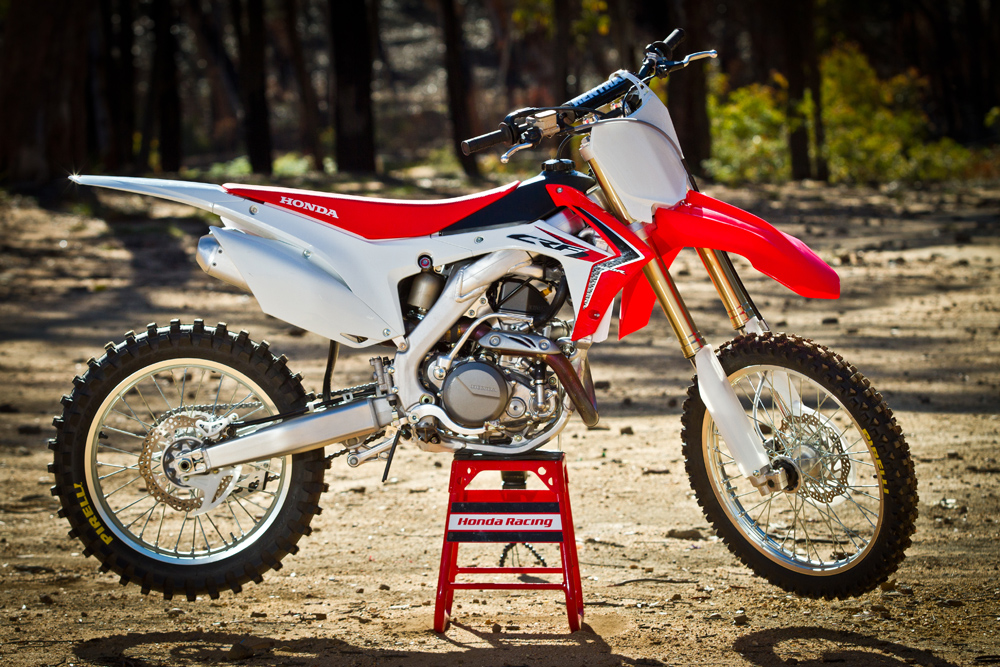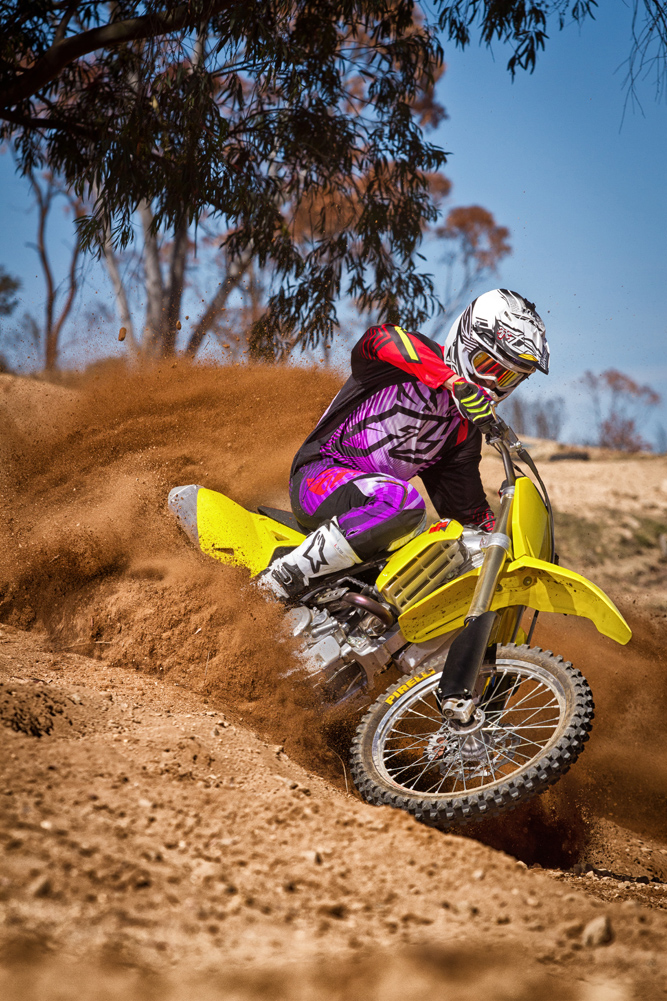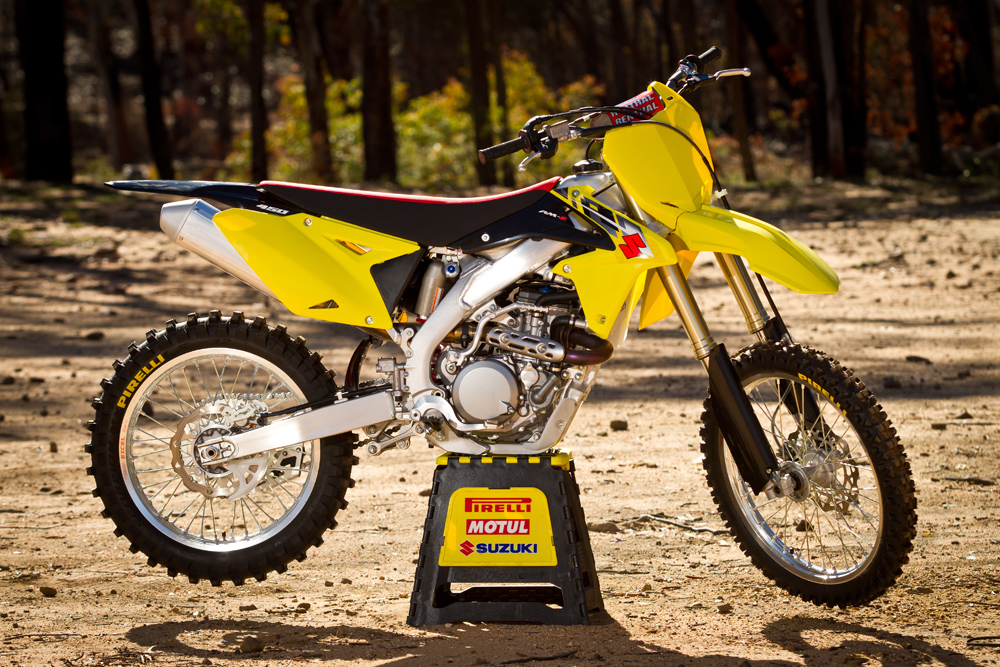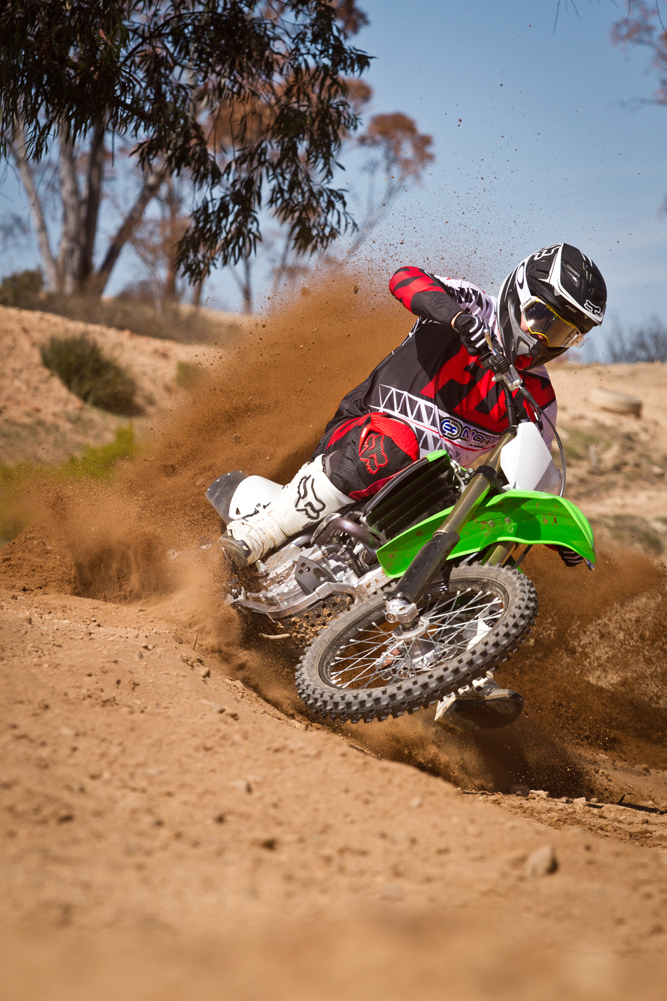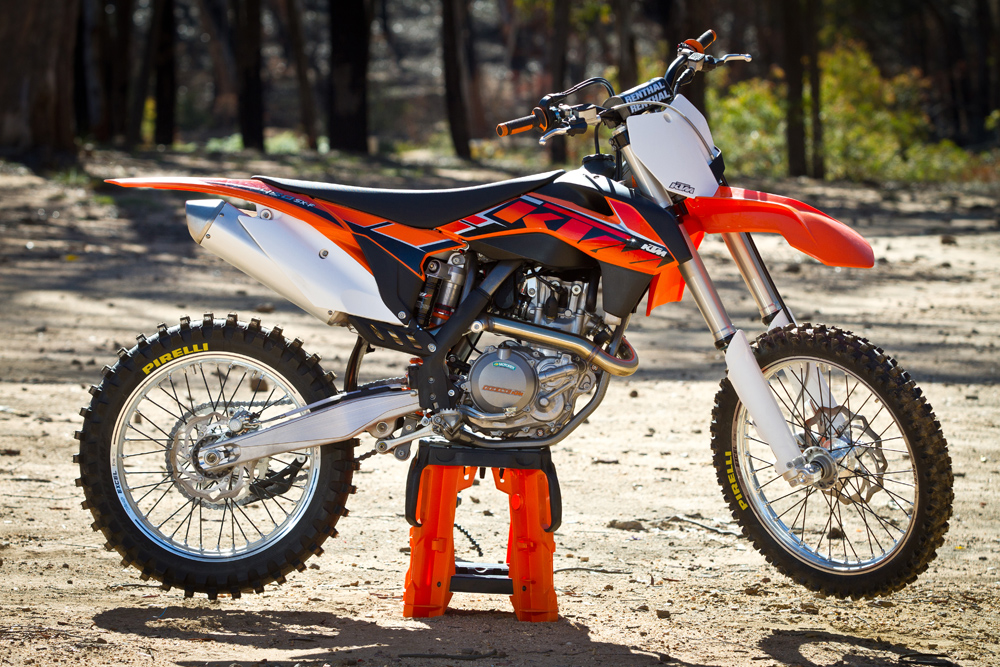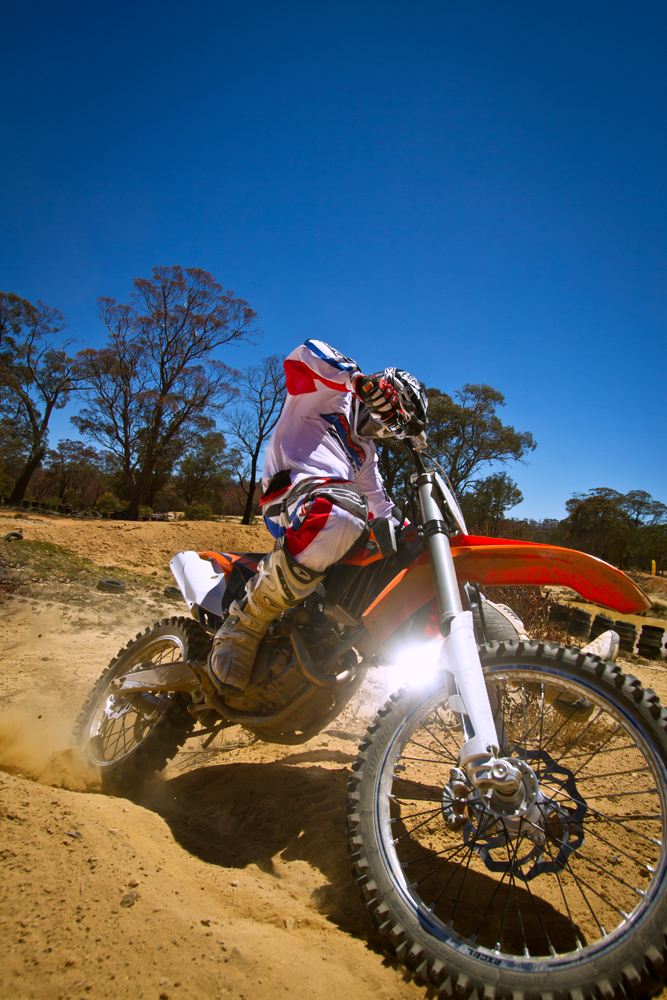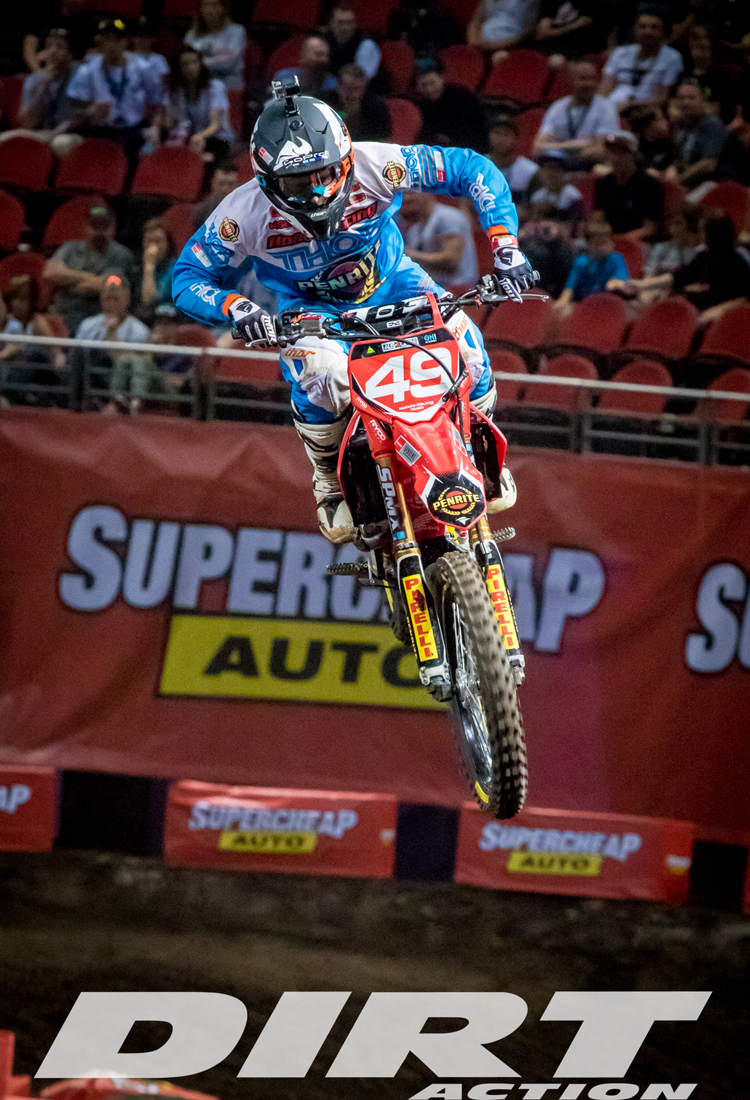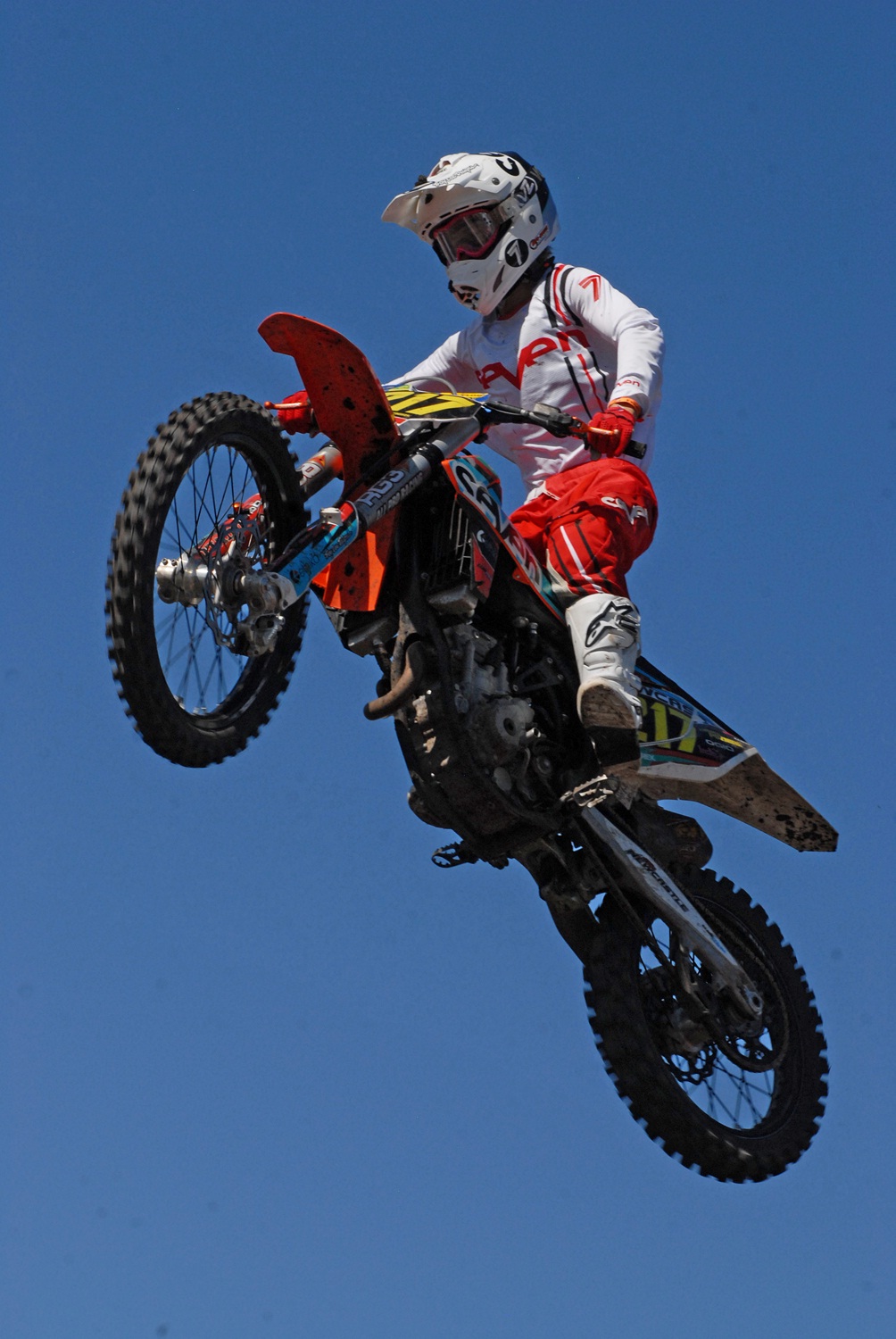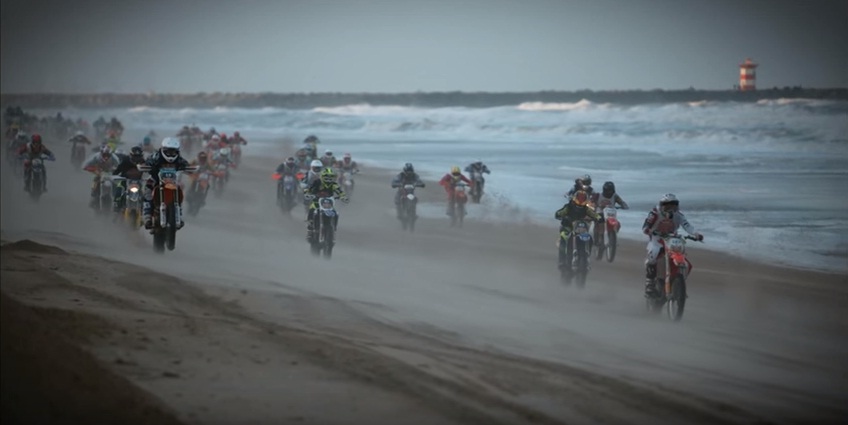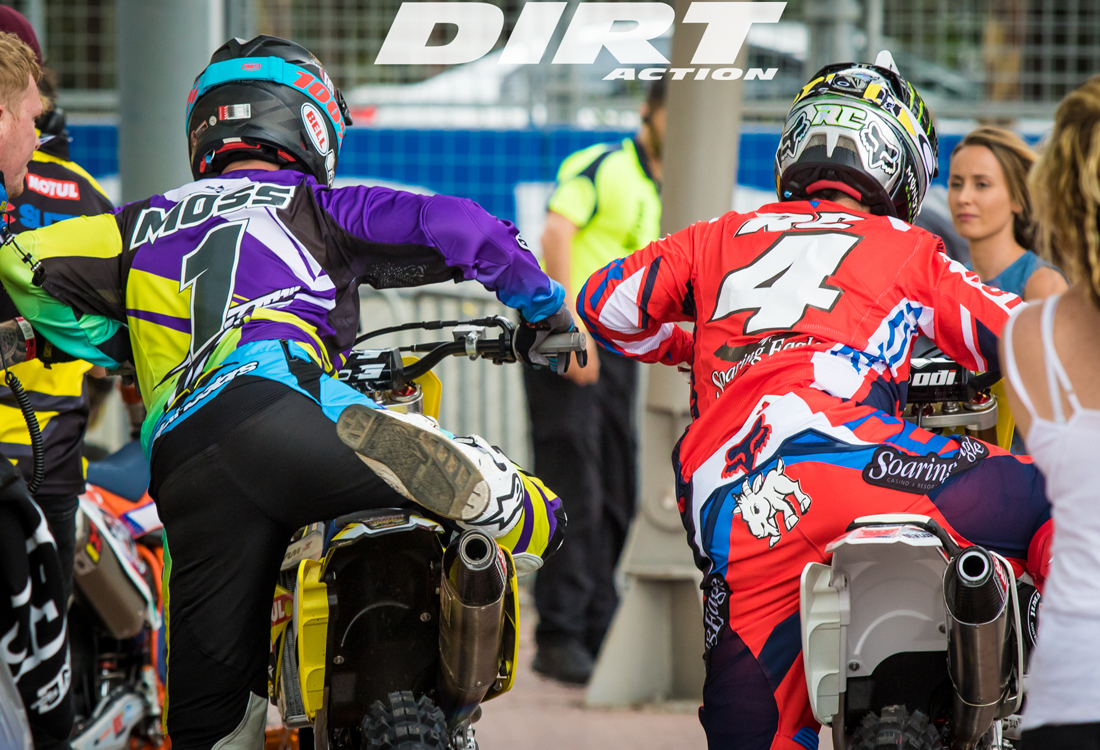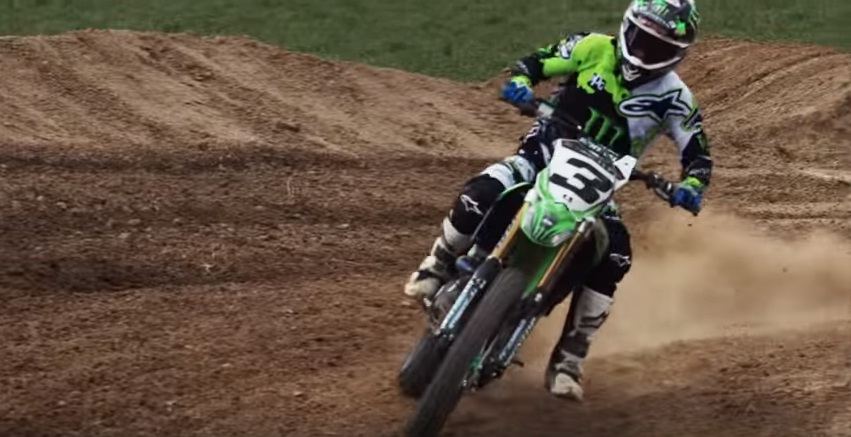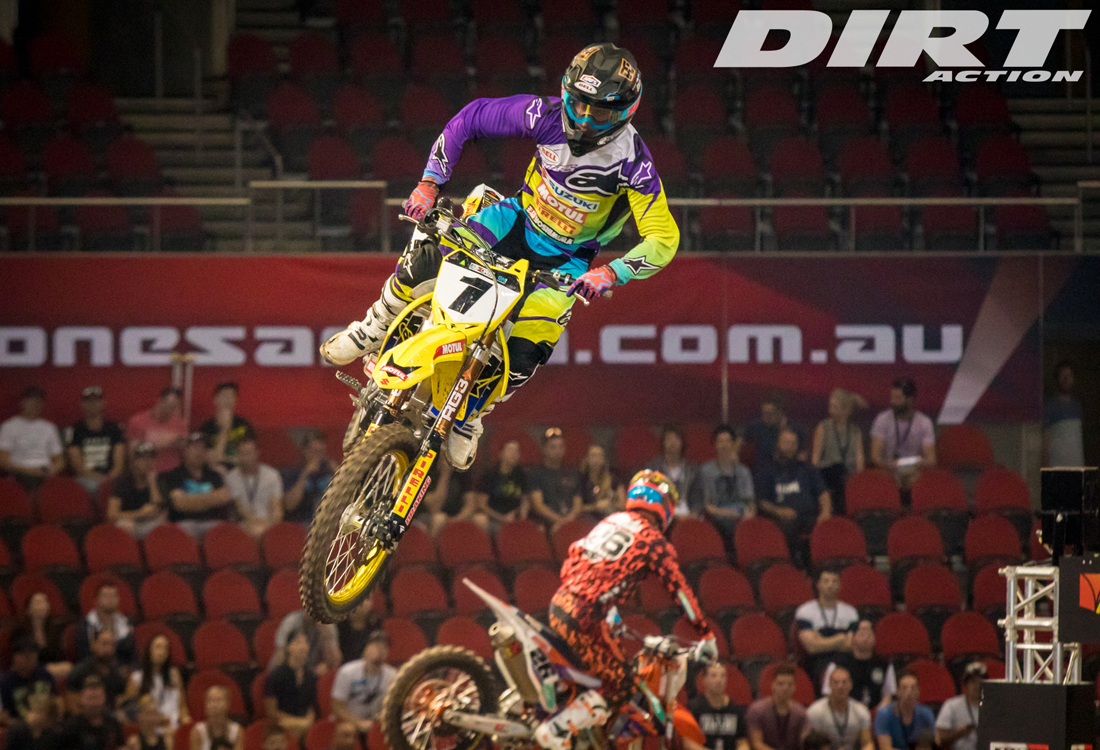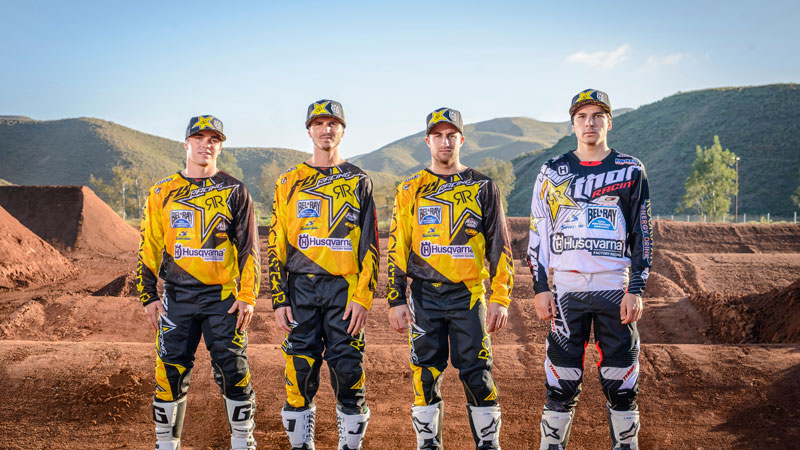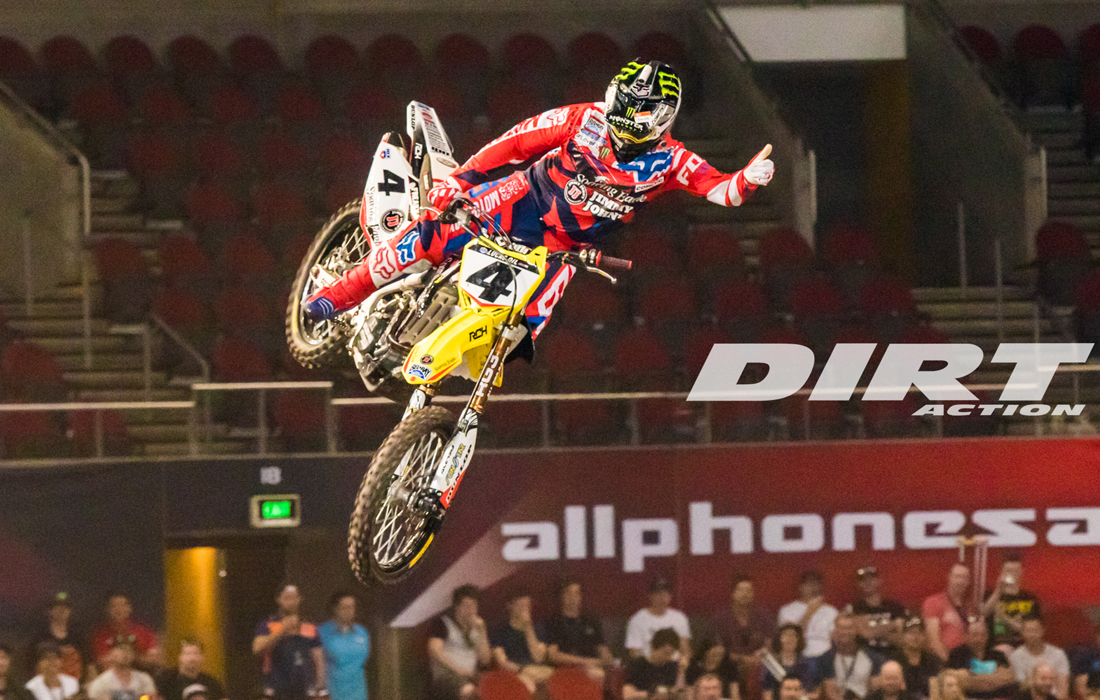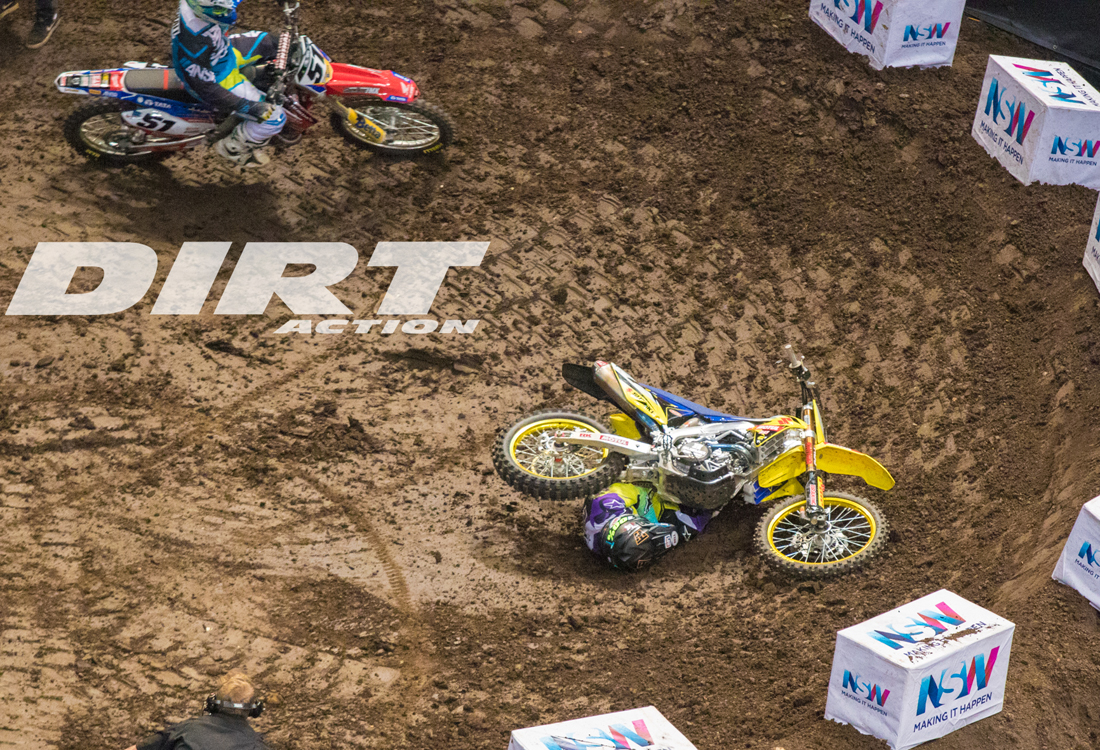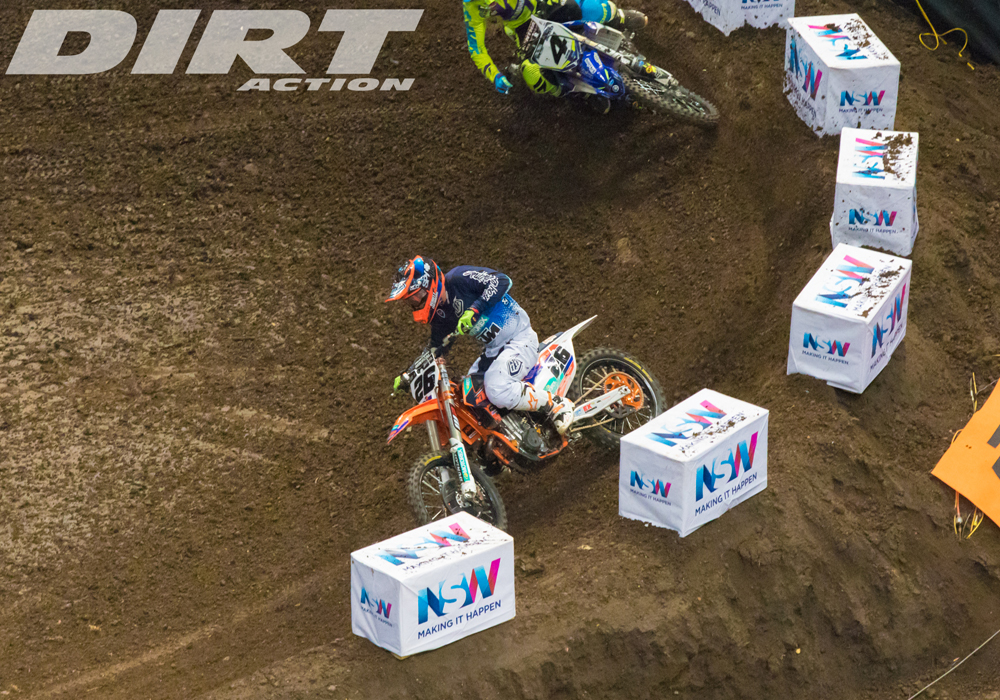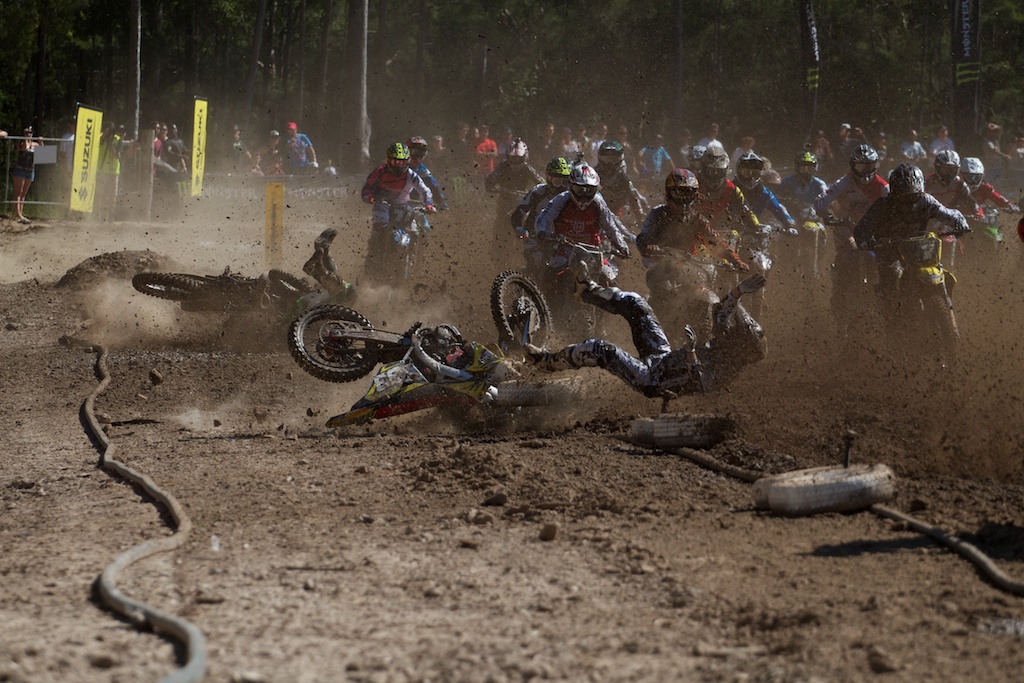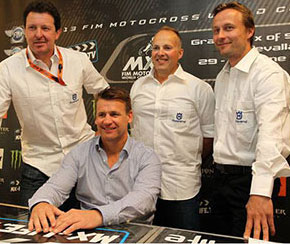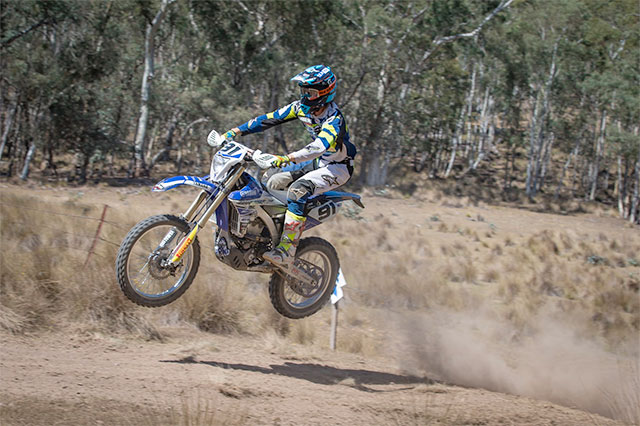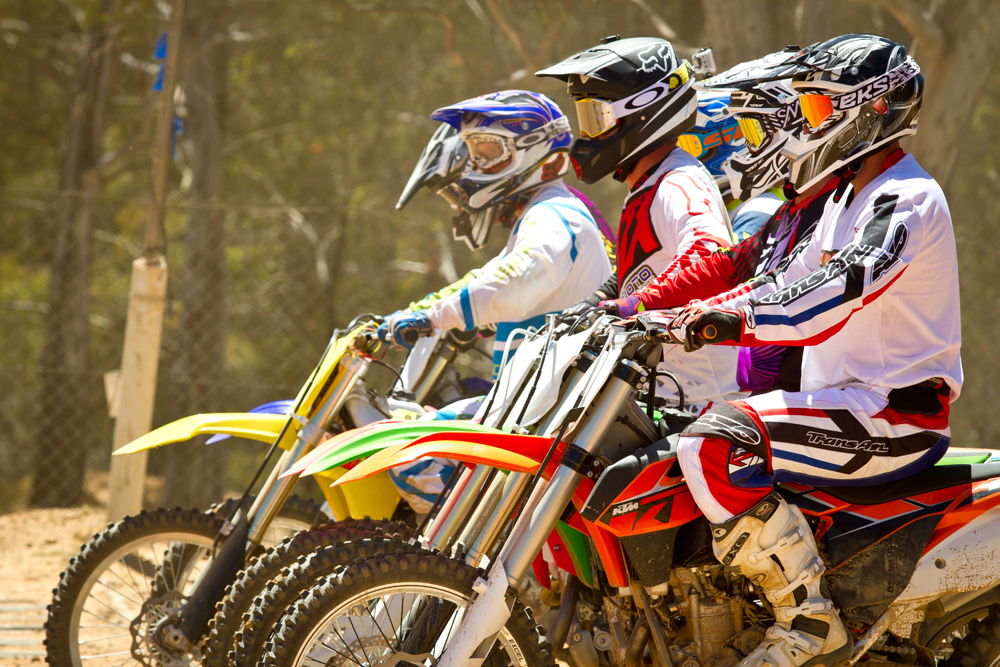
THUNDER ALLEY: Take the top five MX1 contenders, six test riders, 200 litres of Mt Franklins and enough sports tape to run a gymnastics team and we’ve got ourselves a shootout!
STORY SCOTT BISHOP | PHOTOGRAPHY DAMIEN ASHENHURST

THE FORMAT
DIRT ACTION is back in the shootout game. After a few years of testing bikes individually, the team at DA decided it was the right time to round up the contenders and put them all through their paces in the one location.
So, with bikes from Honda, Kawasaki, KTM, Suzuki and Yamaha as well as a technician on hand from each of the manufacturers, we set about digging up as much info as we could to provide you the information you need.
We take the angle to describe each bike in detail so that if you were to lay down your hard-earned $11,000 on a brand-new 2014 motocross 450 bike you’d know what you’re in for. Each of these bikes was presented in standard trim but we used a control Pirelli Mid Soft 32 tyre so the question of tyre performance wouldn’t come into the equation.
We asked the technicians to set the ride height at their recommended levels, set bars, levers and pedals to the riders’ liking and away we went. In a rotating order, each rider got plenty of time to adjust to the bike, making any basic adjustments and then providing feedback. Once all six bikes had been ridden and tested, we then allocated time for the testers to go back over any bikes they felt they needed to gather more info on or get a better impression of.
The only thing you can’t do in a test environment is test durability. This is information a long-term test bike should provide but manufacturers simply don’t have the budget to supply media with their full range of bikes for months on end for us to try to kill them.
In a shootout, we can provide info on the fit and feel of a bike, the performance of the motor, suspension and handling as well as any little tips we pick up along the way, but we can’t and won’t predict the future.
THE TESTERS
We’ve assembled an impressive crew for the 450cc shootout, one with a great range of experience and diversity in speed and skill. Not every guy who buys a 450 is a pro racer, just as not every buyer is a first-time hacker, so we ensured all our bases were covered with the test crew on board.
Long-time testers at DIRT ACTION include Shane Booth and Scott Bishop, both with years of testing under their belts and significant credibility in the industry.
Deputy ed Matt Bernard steps up to represent the casual motocross racer who manages a full-time job but likes to cut loose on the weekends. Matt races at a B Grade level.
Greg Masters takes of the weekend warriors. Greg likes to get off road but doesn’t mind cutting lose on a motocross track and it took us well into the evening to pry him off the bikes.
We also had Andrew Hopson from Axis Motorsport come on board. Hoppo has seen the sport from all angles and all places after working with powerhouse US factory teams. He has a huge mechanical knowledge and is the perfect guy to provide any neutral information on the bikes.
Lastly, we had Michael Byrne join us for this test. Burner needs no introduction but we can tell you he was super excited about being involved and offered a range of insights that only a man of his level and experience can provide. It was the first time he’d ridden a complete range of bikes and, on top of that, he can’t remember when he’s even ridden a straight-up standard bike — for the past 10 years, he’s been given a team bike and just rode what was beneath him.
NO LOSERS
Taking into account that last sentence about Byrne, he came away from the test amazed by the level of performance of the bikes tested. Having raced for factory Kawasaki, Suzuki and Honda in the past 10 years, he’s also had guest rides with JGR Yamaha and a spot on the KTM BTO team. Byrne has raced some of the best factory bikes built during his career so, when he comments on the high level of performance of the 2014 standard models across the board, you know it’s right.
Also take into account the deals out there on new bikes from dealers and manufacturers: cheap finance, performance packs including exhausts, graphics kits and tech info, tents, pressure washers — the whole box and dice. It’s almost like buying a heap of crap and you get a free bike with it.
In the end, buy the bike you feel most comfortable on, the one that suits your needs and offers the best bang for your buck. We can’t tell you exactly what that bike is but we can give you as much information as possible.
So, enough of the chit-chat — let’s go through each bike for a blow-by-blow breakdown.
HONDA CRF450R
In 2007–08, Honda and the CRF450R were kings of the jungle. In fact, many people still believe the 2008-model CRF450R, the last before fuel injection, was one of the best production bikes built. The 2009 was an all-new machine and met with a lukewarm reception around the world. It was good, but not the knockout blow Honda riders were hoping for.
As the development process moved forward, so did the Honda CRF 450, until 2012 when it was again seen as one of the better bikes in the 450 market. That brings us to 2013, when Honda again updated a large part of its 450. Motor, chassis and suspension all received major updates, the introduction of the new air fork seen as the most topical. So now Honda lovers are hoping that, again, the development cycle can kick in and the bike improve each and every year.
WHAT’S NEW?
The motor and the fork received the majority of attention for 2014. New cylinder head porting, new dual–timing fuel injection and a new muffler see out the motor updates while the fork gets new internal spec changes.
ERGOS
I’ve always been a big fan of the Honda fit and feel. I like the shape of the levers, the pull ratio on the clutch perch, the hardness of the seat foam and the thinness of the bike.
But, having said all that, the Honda ergo layout is starting to get a little tight and dated. In a bid to get the cockpit as compact as possible, things are getting snug in there and taller riders look massive on the CRF. It has also has a slight “sit-in” feel. Compared to the Kato, Honda could look at making the layout a little flatter across the seat and tank.
The brakes aren’t bad but certainly not class leading as all the Japanese bikes have very similar brake performance.
MOTOR
Honda Australia imports and distributes the European-spec version of the CRF450R, not the US version. The difference between the two is mainly the exhaust and also the airbox, both which have significant effect on motor performance. The exhaust note on the bikes used in Australia is so quiet you could ride it in a library and not get noticed. Combine that with a choked-up airbox and you have a motor screaming for air and not living up to its full potential.
The bike has a soft, almost gentle-natured motor. It comes on mildly, battles away through a solid midrange and then just can’t quiet unleash in the top end. Most testers said they used a bit of clutch to snap the donk into life on the exit of turns and that clutch abuse did result in some play at the lever. A stronger bottom end would help riders lay off the clutch. As a racer, you listen for an exhaust note to signify when the bike is really up and humming but, with the choked-up exhaust and airbox, you never really get the sound you’re after.
But it is deceptive. As a group we did a number of starts on a long uphill drag and the Honda was always competitive and certainly not left behind. It’s far and away the easiest 450 motor of the group to use and no doubt a perfect fit for a rider looking to make the step up to a 450 or the guy who just doesn’t have the time to train as often as he’d like, as mastering this motor is less physical than with some of the fire breathers in the class.
Honda must be commended on the quietness of the bike. But for racing, the exhaust is the first thing I’d look at to improve the power. The motor has plenty of potential and, by getting a good exhaust, opening up the airbox and maybe some gearing and ignition mapping, it isn’t too hard to change your Clark Kent CRF into a Superman. Or pretty close to it.
SUSPENSION & HANDLING
Honda has engineered a very little motorcycle and this has always been one of their strengths. Not only does it feel light in motion, it actually is, and that has a big effect on the energy required to manhandle it around the track. Every manufacture targets weight and Honda has always done a great job on keeping the weight down on the CRF450R.
The overall feel of the bike on the track is much in line with the motor. Soft, gentle and forgiving were the words most frequently used to describe the bike’s handling. There’s no doubt the frame has plenty of give in it and, combined with its light weight and plush suspension, it does have a way of massaging its way around the track.
The fork was a bone of contention in 2013 and the 2014 model has some changes. The air fork now comes with 35psi standard as compared to last year’s 33psi. This is closer to what the majority of racers used on their bikes in 2013 and offers a better ride up front. Honda riders need to be aware that a 2psi change is equivalent to a spring rate change. There have also been some internal changes and the fork this year does feel a lot better than the one supplied 12 months ago. It has some plushness at the top and a fluid, although softish, stroke.
The shock has a similar ride: again, on the soft side when pushed hard but very tractable and predictable on braking and acceleration bumps. During our testing, ride heights were set between 100 and 104mm for best results and most riders found a setting to their liking.
THE VERDICT
Honda has produced a solid, workable motocross bike, far and away the most manageable and easiest-to-use 450cc motocross bike of the 2014 fleet. It doesn’t have any hard edges or anger management issues; it’s a gentle, friendly motocross bike with enough power on tap to get you from A to B but a heap more if you go looking for it.
The design concept of the bike carries right the way through and if an aggressive, arm-stretching race bike isn’t what you’re chasing, the CRF is right up your alley. It still offers 450cc worth of joy — just in a pleasant and easy-to-use fashion.
MICHAEL BYRNE
The bike felt really small to me. The chassis felt compliant, which gave a smooth feel. The engine felt really restricted, which I think comes from the standard airbox and pipe. It’s a really good entry-level 450 straight off the showroom floor.
SHANE BOOTH
The Honda is a bit of a sleeper among this group of bikes. It seems a little restricted in both the air intake and the exhaust, which really takes the edge off. It doesn’t feel as hard hitting as any of the other bikes but that is very deceiving. This bike won’t tear your arms out but I would bet my house that many riders would be faster with this type of power delivery. The bike’s handling is very forgiving and gives you a confident feel, doing everything well. The ergos of the Honda are almost a little too slim, giving the bike a small feel for me. A few mods to open up the CRF’s lungs and you’ll have yourself a different bike but off the shelf, stacked up with the others, it’s just off the mark.
MATT BERNARD
The front end on the Honda CRF450R feels much improved in standard form over the 2013 model. In the last model I felt it blew through the stroke too easily with the amount of air pressure required to give a plush feel. This model however holds up well and offers a positive feel in the front end. The engine on the Honda lets it down. The bike feels like it’s choked up and begging to be revved. The power is there; it just needs to be unearthed. The bike is thin around the legs and I wouldn’t want any less to hang onto with the knees. Although the bike hasn’t changed aesthetically this year, I’m still a fan of its edgy lines and modern look.
GREG MASTERS
The power didn’t blow my wig back but the handling, controls and seating position had a comfortable and familiar feel. In comparison to the other bikes, it didn’t seem to possess that aggressive MX attitude one would expect from a bike in this class. This could be a good or bad thing, depending on how you look at it.
SPECS
CRF 450
Engine type: 4-stroke, single-cylinder, uni-cam, 4-valve
Displacement: 449.7cc
Bore/stroke: 96×62.1mm
Compression ratio: 12.5:1
Fuel management: PGM-FI
Fuel capacity: 6.4L
Transmission: 5-speed, constant mesh
Length: 2191mm
Width: 827mm
Height: 1271mm
Seat height: 953mm
Wheelbase: 1492mm
Ground clearance: 330mm
Wet weight: 111kg
Frame type: Perimeter, aluminium
Suspension front: 48mm inverted air fork
Suspension rear: Pro-link
RRP: $10,697
JLT INSURANCE QUOTE: $373.49
SUZUKI RMZ450
The Suzook has been a popular mount in the 450 division for quite some time. The glory days in the US of Carmichael, Reed and Dungey might be over but Matt Moss has more than picked up the slack in Australia and the bike is always seen as one of the better in the 450 class — and almost the preferred factory bike among racers around the world.
Despite a major update for the 2012 season, the RMZ450 remains one of the older-style bikes. There is no funky sideways-facing motor, vertical exhaust or NASA-approved suspension components. It’s built from years of Suzuki experience and knowledge with a range of components and parts that Suzuki knows works. It might not leap off the showroom floor with bling and technology but is still a very effective motocross weapon.
WHAT’S NEW?
No much is the right answer. Some of the bike’s styling and design go all the way back to 2008–09 but the majority of things were updated for the 2012 model. The list for 2013 is short and the RMZ is ageing but rumours suggest a new machine is on the way and might be here as soon as 2015. The ECM program was updated as were the radiator shrouds.
ERGOS
When the hot start lever is on the right, you know you’re on board a Suzuki. The Renthal twin wall bars that grace the top of the RMZ are a comfortable bend and with the slim midsection of the bike it’s easy to climb all over the Suzuki.
Michael Byrne, who hadn’t raced a Suzuki since 2009, put it best when he leapt on board and said it feel like nothing has changed in that time. The layout of the bike is old but not yet dated. The brakes are run-of-the-mill Japanese. The throttle pull is super light, as is the clutch, and the seated position is more neutral than aggressive.
MOTOR
It’s not the most powerful nor the most responsive; it doesn’t have the most torque or top end — but the RMZ motor does offer a good compromise of all those traits and spreads it across the rev range. Its strength is in the bottom and midrange where the roll-on power does a great job of getting the RMZ up on the ground and running.
It falls off a little up top when compared to the KXF, KTM and YZ, but for the conditions and tracks we face in Australia that isn’t a major concern. The majority of our tracks have low average speeds and are point-and-shoot affairs, so the low and mid power concentration works a treat.
We started our testing with the standard coupler but threw that back in the toolbox after a handful of laps, opting for the leaner one. With the lean coupler in, the motor sparked up with a more responsive feel, some hit in the power and a bit of a racers edge. Suzuki suggests the lean coupler works best with the RMZ when in standard trim.
HANDLING & SUSPENSION
The first change of direction on the RMZ makes you realise this bike is designed to corner. It’s a precise, sharp-turning bike, a trait long present in the majority of Suzuki’s motocross models. Nothing out-turns an RMZ in the big-bore class.
The fork was probably the biggest area of concern as riders struggled to get a setting they liked. Faster guys said it was too soft and went to full hard to get some substance in the stroke, while slower guys went the opposite way to full soft as they complained the bike was too firm. The end result was if you wanted a plush bike, you went soft, but it blew through the stroke; if you wanted it harder you cranked the compression in but you got a harsh ride.
The shock feels a little dead and, despite a heap of changes going on up front from riders, the rear of the bike remained the same. It was workable, certainly rideable and in standard trim a predictable and reliable unit. With the bike already a strong turner, setting the shock up for some stability is a good idea and a 105mm ride height is a good place to start.
THE VERDICT
The RMZ has been a popular bike and it’s easy to see why. It’s a simple, uncomplicated machine that works. The motor has nice, strong roll-on power that’s well suited to our local conditions. The chassis wants to change direction as soon as it sees a corner and it’s a very easy bike to use. The only downfall is a fork that requires some setting up. Refined and reliable are two words I would use to describe the RMZ450.
SHANE BOOTH
This bike probably took me the longest to feel comfortable on and initially I really couldn’t really put my finger on why. I firmed up the fork, which improved the overall feel quite a bit, and as I became more comfortable and the speed increased the bike felt better. It definitely felt better the harder I rode it. The power delivery was strong but felt like it levelled off ever so slightly in high rpm. The RMZ’s ergos allow you to do what you need to without any problem, which is nice. This bike slotted in just behind the leaders for me.
GREG MASTERS
I found the RMZ to be a bit of an all-rounder. The bar position felt lower than the other bikes but it was still comfortable. The bike had a smooth power delivery that hooked up well on the dry and dusty track. The RMZ to me felt the lightest to handle of the 450s out on the track. I’m also a huge fan of the way the RMZ turns, especially in the flat corners. A good all-round package and very much a race-winning contender in its stock form.
MATT BERNARD
I felt slightly cramped in the Suzuki cockpit, so I’d definitely go for a higher bend of handlebars if I was to own one. The Suzuki had a strong engine, but not quite as beefy as the Yamaha or the Kawasaki and nowhere near the brutal explosion of the KTM. To me, this bike is kind of difficult to sum up with any kind of strong critique. It did everything fairly well but didn’t stand out in one area ahead of the others. With some high bars and maybe an exhaust to let the Zook rev freer, I’d be happy.
MICHAEL BYRNE
The Suzuki’s engine felt good. The rear suspension worked well for me but the front end felt very soft, I firmed it up as hard as I could, which helped, but [it] still never felt like what I was looking for. Maybe it’s the SFF fork that didn’t quite feel right. Perhaps in the future they’ll go to the air fork.
SPECS
RMZ 450
Engine type: Single-cylinder, 4-stroke, liquid-cooled, DOHC
Displacement: 449cc
Bore/stroke: 96×62.1mm
Compression ratio: 12.5:1
Fuel management: Suzuki fuel injection, Keihin 43mm
Fuel capacity: 6.2L
Transmission: 5-speed
Length: 2190mm
Width: 830mm
Height: 1270mm
Seat height: 955mm
Wheelbase: 1495mm
Ground clearance: 325mm
Wet weight: 113kg
Frame type: Perimeter, aluminium
Suspension front: 48mm, Showa Separate Function Fork (SFF) Type 2
Suspension rear: Showa rear shock
RRP: $11,790
JLT INSURANCE QUOTE: $373.49
YAMAHA YZ450F
Yamaha was in a spot of bother with the YZ450F. The reverse cylinder model of 2010–13 had gained a bad reputation in the US for its quirky handling and its unpopularity with pro riders. There wasn’t much success in Europe either, so sales in both of those major markets came grinding to a halt.
In Australia, things were much rosier for the YZ450F as CDR won championship after championship on the bike and sales figures here remained strong. But Yamaha knew the bike was in desperate need of an update as it was effectively a 2010 model with new graphics and a white rear guard.
That update comes in 2014 with a heap of hype. In a year when the majority of new bikes are just warmed-over 2013 models, Yamaha comes out all guns blazing with both 250 and 450 all new, hoping to make up for lost time.
WHAT’S NEW?
Everything! Sure, the cylinder head still faces the other way, but everything on the bike with the exception of the front guard and fork protectors has been changed or updated. It’s an all-new bike, said to have been in development since late 2009.
ERGOS
It’s always strange that a manufacturer can change everything on a bike and still end up with a bike that feels the same as the previous model when you sit on it.
The bike is 14mm narrower across the radiators, which is a big step in the right direction. Some riders said it still looked biggish but didn’t notice it when riding. The handlebars are now 10mmm closer thanks to the redesigned frame but retain the four-way-adjustable triple clamps to fine-tune bar placement. Those clamps are rubber mounted to reduce vibration.
The fuel cap takes a bit of getting used to and so far we haven’t heard of any dramas removing the front portion of the seat. The brakes are par for the course. The grips seem to be softer than the rubber cement of a few seasons ago and the bike just feels like a Yamaha.
MOTOR
Everyone in the world wants more power that’s easier to use, but it’s easier said than done. Last year the YZ450F had this abrupt surge as soon as you looked at the throttle, charged hard for the next quarter of a turn and had a little rest before coming back with more aggression in the top end. It was fast and sometimes furious but never dull.
So, for 2014, Yamaha engineers amped up the power, spread it across the entire range and tried to mellow it the instant the throttle was cracked open. You’d have to say they succeeded. It’s still sharp and responsive right from idle, but not enough to set you back in your seat. The power is more metered as it generates ponies in the lower and bottom end and far more manageable than the 2013 donk.
Midrange and top end are muscular and powerful, many saying it’s the most powerful in class. Regardless of what a dyno says, this motor sits right alongside the KTM and the KXF as best in class and you’d be hard pressed to pick a winner as they all offer the right ingredients for a 450cc motocross engine.
The GYTR Power Tuner is a handy tool for fine-tuning power and a simple way to get the most from your YZ450F. It’s not going to drastically alter the nature of the bike but it does do enough to suit the conditions you’re faced with during the day or a season.
SUSPENSION & HANDLING
The issue riders faced last year wasn’t the suspension action, as most found the KYB fork and shock to be as good as any in the class. They spoke of a vague front-end feel on corner entry; also, the abruptness of the power made the bike stand up on corner exit.
To get more traction on the front wheel, the front end was pushed in 10mm and the softer power delivery addressed the stand up on exit. The YZ450Fis a far better-handling machine than the model it replaces.
When riding the Yamaha back to back with all the other brands, there is certainly more rigidity than can be felt in the chassis. It does feel stiffer on the whole, especially compared to the CRF, which is forgiving and almost feels flexible. Faster riders loved the rigid feel of the YZ as it allowed them to charge at anything on the track. Slower riders opted to take some of that feel out by backing off the suspension settings.
The KYB fork isn’t new but is still very effective. The rumour is that Yamaha elected not to spec its bike with the air fork until it feels it’s better than what the brand already has. The SSS units work well. The shock also does a good job and riders need not be afraid to lower the ride height a little more than usual. Even at 108mm ride height, riders found the bike still turned well but increased its straight-line stability.
THE VERDICT
The Yamaha is easily the most improved bike in the fleet; it is also the only one that received major changes. The engine is now banging bars with the best of them, the chassis is far more manageable and the handling far more predictable. Yamaha owners will feel a major change in this bike over the last one and it’s all positive.
MICHAEL BYRNE
I definitely was surprised with the Yamaha after what I’ve heard and last time I rode one. The engine was really smooth and strong and the only thing that maybe kept it from the top of the list was [its] being slightly unbalanced. The front felt a little soft compared to the rear but overall it’s much improved from the last YZ450 I rode.
SHANE BOOTH
The new Yamaha retains a strong engine that feels as though it’s been refined to deliver its horsepower slightly smoother than the 2013 model. Its overall power is impressive and on par with the strongest in this class. The new chassis has resulted in a much lighter and more nimble feel. The balance of the bike gives a very solid front-end feel and I felt more comfortable when the front of the bike was firmed up and the rear softened slightly. I think the new shape looks nice and modern plus it offers a comfortable seating position. Overall, this bike was at the pointy end of the list for me.
MATT BERNARD
Having a project YZ450F, I was immediately comfortable on the YZ. The cockpit on the Yamaha is very easy to get used to, however. With everything sitting in a comfortable position it’s a bike the majority of riders should feel comfortable on very quickly and with minimal adjustment. I rode the 450 with the bar clamps in the forward and standard positions; I preferred standard. The engine on the Yamaha is very strong but extremely usable; it’s got heaps of poke but comes on in a controlled manner. It’s easy to carry third gear regularly and short shift the bike. I was happy with how the bike handled and found it one of the nimblest across the rough and bumpy terrain. This bike is rated extremely highly in my book and sits firmly alongside the Kawasaki as my favourite bikes out of this bunch.
GREG MASTERS
The YZ has got some serious grunt — the thing pulls like a tractor! It has some serious ponies but I found it to be very manageable. The power was like having a gun under the bed — it’s just nice to know it’s there if you need it. The ability to move the bar mounts forward in triple clamp to open up the cockpit is a great option to have as a bigger rider. The no-fuel-cap idea opens things up as well. No wonder Matt has the new ’14 YZ as his project bike.
SPECS
YZ 450F
Engine type: Liquid-cooled, 4-stroke, DOHC, 4-valve
Displacement: 450cc
Bore/stroke: 97×60.8mm
Compression ratio: 12.5 : 1
Fuel management: Fuel injection
Fuel capacity: 7.5L
Oil capacity: 0.9L
Transmission: Constant mesh 5-speed
Length: 2180mm
Width: 825mm
Height: 1280mm
Seat height: 965mm
Wheelbase: 1480mm
Ground clearance: 330mm
Wet weight: 111kg with 7.5L fuel
Frame type: Bilateral beam frame
Suspension front: Telescopic fork, 310mm travel
Suspension rear: Swingarm (link suspension), 315mm travel
RRP: $11,999
JLT INSURANCE QUOTE: $373.49
KAWASAKI KX450F
Ever since the major overhaul for the 2012 season, the Kawasaki 450cc machine has been at the pointy end of shootouts and media awards around the world. Kawie took a heavy, fat and lazy 450cc bike and trimmed the weight, narrowed the girth and pumped up the juice for 2012 and the bike has been a hit ever since.
Let’s use Chad Reed as an example. His foray into Kawasaki in 2010 was a failure and he stated that he struggled significantly with the bike. Just four years later, after some major changes to the KXF450, Reed is back on green after testing nearly every bike available and said to be pumped with the bike’s improved performance.
WHAT’S NEW?
The long and the short answer is nothing. Well, unless you include bold new graphics as an update. The 2014 KX450F is the 2013 KX450F. Fortunately for Kawasaki, the majority of the other brands also went for the BNG so they didn’t get left behind.
ERGOS
The KXF has one of the more open rider layouts — so open that, even though the standard clamps have some adjustment in them to make it more spacious, next to no rider uses the front mounts on the standard clamps.
On top of that adjustment, Kawie also offers the adjustable footpeg mounts which give riders around 10mm difference between the two optional footpegs mounts. It might not be essential but it’s a good option to have to help fine-tune yourself with the motorcycle.
The tank, seat and bars all feel natural and the Renthals used are a good bend. It was only a few millimetres Kawasaki trimmed the chassis girth down in 2012, but it’s certainly noticeable and a change for the better. Lever pull is light on the clutch and the brakes are standard Japanese units.
MOTOR
This is the motor by which the others have been judged. Sure, some might have more up top, others might burst of the bottom with more authority, but when it comes to pure power and power delivery it’s the Kawasaki KX450F that stands tall.
The throttle feels connected and response from hand to motor to rear wheel is quick. Then comes a long, muscular surge of power that just continues right through the rev range — powerful but not in an intimidating way. Yes, it makes 56-plus horsepower. Yes, it’s race orientated but it doesn’t hit or surge, thrust or kick. Just look at the throttle as a volume control and turn it up and down as you need it.
Kawasaki offers an optional soft or hard mapping plug to fine-tune the power. Soft and hard refer to the track surface, soft giving you a more aggressive feel while hard tapers the power off a little. If you’re to run the motor in standard trim, we suggest the soft plug as it just sharpens up the whole rev range and gives a livelier feel when on the track.
There is also a traction control feature that can be used during starts. Once the red light is on in the unit on the left-hand side of the handlebars, the ignition is slightly retarded in an effort to reduce wheel spin and gain maximum drive from the start gate. Once the bike has been shifted up a gear, it reverts to the programmed ignition curve. I think it’s half gimmick, half practical; I’m not fully sold on the practical use of it in the real world yet.
SUSPENSION & HANDLING
Over the past couple of seasons, Kawasaki has developed a good compromise between an agile and precise-steering bike and a stable and calm bike at high speed. It was always solid in high-speed stability but the chassis change of 2012 added agility to the list of features and the KXF450 is now seen as one of the better handlers in class.
To fine-tune the steering, we just played with the fork tube height in the clamps. We ran them flush with the clamps when there was plenty of traction on offer and slid them 5mm down when we were searching for more front-wheel feedback.
Kawasaki switched to the air fork for 2013 and seemed to have better success with it than Honda’s first attempt. The base setting seemed to be a little more fine-tuned from standard and, as a result, rider talk in the pits about the new KXF fork was almost non-existent.
When set at the 35–36psi range (35 is stock), the fork works pretty well. The advantages of switching to the air fork are that it is lighter and easier to adjust and the next level of technology from which to develop suspension. At this point in time, a well-set-up air fork is about as good as a well-set-up spring fork so it stands to reason the air fork will be the way of the future.
For me, I like the feel of the air fork on braking bumps as it offers a slightly plusher feel than a spring fork when set up well. The horror stories of leaking air and diving forks still scare me but seem a little more few and far between these days.
The shock was a 100mm set-and-forget. No riders over the day had any major issues with the shock performance and all felt the rear end was a highlight of the bike.
THE VERDICT
This is one impressive 450: a motor to die for, a chassis that caters for a wide range of riders and skill, sorted suspension and a proven record on the race track are what you get when buying a KX450F. Kawasaki didn’t change much for 2014 and it probably didn’t need to as its major overhaul in 2012 picked up the majority of the issues. Some fine-tuning in 2013 and now 2014 has left the Kawie a very refined bike. Fast guys, slow guys, fit guys and lazy guys all loved the KX. From tyre to tyre, it’s one hell of a bike.
MICHAEL BYRNE
It didn’t do anything awesome but I never felt I needed to change anything. Everything felt like it was in the ball park for a standard bike and the engine was solid and smooth. Overall, it was probably my pick as the best package.
MATT BERNARD
For me, the Kawasaki had a nice and strong engine without the need to rip my arms out and supply a dose of whiplash. I was able to short-shift the bike around the skatey turns and open it up when there was some traction in the sandy berms. The forks on the Kawasaki were really good; [they] transferred a responsive and positive feel to the handlebars and I had a lot of trust in the front wheel sticking to the dirt. I’m not a big fan of the soft sit-in seat that the KX produces, although it’s a Kawasaki trait and I was pretty used to it fairly quickly. To me, the Kawasaki was my pick. It was easy just to jump on and go for it. Ticks to a great engine and great suspension package. Crosses for standard-sized bars and horrible grips. It would come down to the Kawasaki or the Yamaha as my favourite with the KX just ahead. I’d march down to the local dealer and see who’d do the best deal.
GREG MASTERS
After only a couple laps it was obvious to me that this was the bike that ticked all of the boxes: motor, brakes, steering, suspension ,controls, cockpit etc. Initially, the seating position felt lower compared to the other 450s but I personally don’t mind that. The cheese-grater stock grips would have to go but that’s no biggy. I felt I could keep a good momentum going all the way around the track. There were no stopwatches used so who knows, but I also felt quicker on it than on the other bikes. The KX 450 for me was the most well-rounded bike I rode on the day.
SHANE BOOTH
This is a 450 that I’ve always felt comfortable on and the 2014 model is no different. When I headed out on the track, nothing really stood out to me; everything just did what I felt it should. There wasn’t anything happening that was negative. It has a solid handling feel and the air forks provided a confident feel. The engine is powerful and packs a strong bottom-to-mid punch without paying for it drastically up top. If there was one thing I could pick the KXF for it’s that you sit in it slightly more than the other bikes. This is a solid bike right off the dealer floor and for me is battling with the Yamaha for the top spot.
SPECS
KX 450F
Engine type: Liquid-cooled, 4-stroke, single DOHC, 4-valve
Displacement: 449cm3
Bore/stroke: 96×62.1mm
Compression ratio: 12.5:1
Fuel management: Fuel injection ø43mm×1 (Keihin)
Fuel capacity: 6.2L
Transmission: 5-speed, return
Length: 2180mm
Width: 820mm
Height: 1275mm
Seat height: 955mm
Wheelbase: 1480mm
Ground clearance: 330mm
Wet weight: 112.5kg with full tank of fuel
Frame type: Perimeter, aluminium
Suspension front: 48mm upside-down telescopic Pneumatic Spring Fork (PSF)
Suspension rear: New Uni-Trak
RRP: $11,999
JLT INSURANCE QUOTE: $373.49
KTM450SXF
It wasn’t that long ago that the KTM450SXF was the tail-end Charlie of the 450 field. It always had power but struggled to get it to the ground. KTM wasn’t really taking the class seriously as its investment dollars seemed to be directed at the smaller-capacity bikes.
Then some things changed. KTM wanted in on the US scene. It wanted to establish itself as a credible brand in the US and run a race team that riders aspired to be in. Within a short time it’s more than met those goals. Roger DeCoster was bought on board to control the race team and Ryan Dungey to showcase the bike on track; suddenly KTM was everywhere and the race wins started flow.
On top of that, the production bike has improved enormously of late. The KTM450 is now recognised as a frontrunner in the big-boy class in tests and shootouts around the world. The company is on a roll — and on a global scale.
WHAT’S NEW?
The new 450 comes with a change of gearing to 13/50, stiffer clutch springs and an updated exhaust. Not much in the way of ground-breaking technology but all of them can and do make for a different effect on the bike.
ERGOS
All of the adult KTM bikes feel the same from the saddle: roomy, spacious and with the bare necessities to go racing. The brakes are class leading and the clutch hydraulic.
MOTOR
Well, when you step onto a KTM450SXF, within the first 100 metres you become aware you’re on board a 450cc motocross weapon. This motor pumps out some serious ponies. KTM has never had much trouble developing power and it wasn’t that long ago that the 450SXF had a slow-revving, almost off-road power delivery. That day is gone.
The KTM now produces a quick-revving, responsive and powerful race motor. It’s almost like it’s changed its target audience from the conservative kids of European MX to the amped-up, high-octane, sideways-hat-wearing animals of US supercross. It’s a lively feel off the bottom that just continues to build momentum all the way to the throttle stop. It’s fast, not over-aggressive and certainly a motor that excites the rider.
In terms of comparing it to other motors, both the Kawie and the Yamaha feel like they produce a similar amount of power and are ahead of the Suzuki and Honda. The Kato is a bit smoother off the bottom than the Japanese bikes but still packs enough thrust to make it go. Midrange, it comes into its own and the top end is class leading.
SUSPENSION & HANDLING
One area where KTM needed to improve was in the setup of the production bikes, especially the bigger-capacity ones. What you can get away with on a smaller capacity 250 or 125 doesn’t apply with a big bore 450. The weight, power and speed of the bike all magnify any issues in setup or design.
Thankfully, KTM has put hours of R&D into the 450 and it’s now a solid-handling 450 machine. The fork offers a plush ride for all but the fastest riders and holds up nicely in braking bumps. If you pull a couple of “Crazy Ivan” laps, you might get a bit too much travel going on; but for our conditions and the speed of the riders buying this bike, the KTM450 forks work pretty well.
The shock takes some careful setting up as it can be quite sensitive to any adjustment. Right from new, the ride is a bit busy. As with the 350, the back just moves around a bit much, especially on acceleration bumps. Our solution is to play with ride height to get the feel you like. Some riders went beyond the 100mm of ride height to get the rear to settle while others stayed at 100mm, dialled in some clickers and spent some time with fork height. It can be made to handle well; it just takes some input from the rider to get the best out of it.
THE VERDICT
There’s no doubt the KTM is right in contention for the shootout win. It packs a motor that impressed every test rider, some solid and predictable handling and a high-standard build quality. It ticks all the boxes of what a rider needs to go fast. There’s a reason more orange bikes are appearing at your local track and that reason is that the level of KTM’s production bikes has stepped up considerably. This is a good motocross bike.
MICHAEL BYRNE
The KTM450SX had the strongest engine out of the bunch but the suspension felt a little twitchy to me. It never really felt planted in the rear but it has a very nice engine, brakes and clutch.
MATT BERNARD
“Holy shit!” That was the first thing I thought when I cracked the throttle on the KTM450SX-F. The engine on the KTM is very strong. On a grass track or a loamy, watered and prepped motocross track, it would be wicked fun. However, Clarence was getting dry by the time I got on the KTM450 and I got myself into a few serious moments due to the extreme burst of power delivered by the right wrist. I wasn’t 100 per cent confident with the front end of the bike, which didn’t help my scary moments. In the right hands, this thing is a loaded gun ready to be fired to the front of the field. In the hands of an arm-pump-suffering C-grader on a hard-pack surface, it’s a wild ride. The ergonomics on the KTM were one of my favourites. The quality of the motorcycle is first class. The grips are good, the handlebars oversized and the footpegs nice and meaty.
SHANE BOOTH
The engine on the KTM will blow your wig off. It has power on tap and will be a handful for plenty of riders. It’s not uncontrollable — just aggressive. If your throttle control isn’t on point you may find yourself trying to reel the bike back in now and then. The KTM had a different handling feel to me than any of the other bikes, something that might take a little to get used to. It felt a touch on the harsh side if I had to describe the difference — not at all horrible, just different. As always the brakes, hydraulic clutch and electric start all receive a gold star from me and this bike really stands above the rest in those three departments. The 450 SX is fast but for me isn’t the same overall package as the KXF or the YZF.
GREG MASTERS
I just loved the seating position on the KTMs! I’m six-two and have a tendency to sit toward the back on most bikes; however, 0the SX seemed to let me get right up on the cap without thinking about it. The motor has power on tap but I felt some of the other bikes put it to the ground better. This bike has some trick components like Brembo brakes, hydraulic clutch and Domino grips. Although a little weird at first, the electric starter would start a stalled motor in a flash after a tip-over in a race.
SPECS
KTM 450
Engine type: Single-cylinder, 4-stroke, SOHC, 4-valve
Displacement: 449.3cm³
Bore/stroke: 95×63.4mm
Fuel management: Fuel injection
Fuel capacity: 7.5L
Transmission: 5-speed
Seat height: 992mm
Wheelbase: 1495mm
Ground clearance: 371mm
Wet weight: 114kg
Frame type: Central tubular frame made from chrome moly steel tubes
Suspension front: WP suspension
Suspension rear: WP suspension
RRP: $11,495 + dealer delivery
JLT INSURANCE QUOTE: $373.49
KTM 350SXF
I have to tell you, I wasn’t a huge fan of the 2011 KTM350SXF when it was introduced. It felt as heavy as a 450 on the track and went like a 250. It needed to lose weight and gain power all at the same time before it could be taken credibly and then it still needed to find a class to race in as it was caught in the middle of the major racing classes around the world.
In 2013, the KTM 350 got what it needed. Some weight was saved, the power was pumped up considerably and at least now it felt like a bike that was viable and a worthwhile option for the ride rider in the right circumstance.
I still struggle with where the bike fits in; so it seems does the rest of the racing world. You can’t race it in the MX2 or Lites class, so it must be an MX1 or Open bike — but you don’t see too many on start lines around the world. Cairoli is rumoured to have anything from a 350 to 420cc depending on who you listen to while anyone in the AMA world has all but ignored the bike.
WHAT’S NEW?
KTM made a range of small-detail changes to the 350 for 2014: the chain guide, seat foam and a few other things got some minor updates. The bigger changes happened in the fork and also in the ignition mapping to help give the 350SXF some more thrust.
ERGOS
Not much has changed in the KTM bike layout in recent years. Despite compacting the design over time, KTMs still have the roomiest rider areas of all modern motocross bikes. They are also minimalist, with no excess junk. There are the bars, the world’s smallest bar pad, some levers, grips and a couple of cables — and that’s it.
KTM brakes are the most powerful in motocross. They still retain a good, positive feel about them. The front is a one-finger operation; the rear has always been strong but in recent years the grabby feel has been reduced. The hydraulic clutch is great for all conditions apart from deep mud or sand as it’s hard to sense when the clutch is going away as the lever feel doesn’t change. It’s a good question why none of the Japanese brands have gone to the hydraulic clutch yet and one we don’t know the answer to. Strangely enough, race teams on Japanese brands seem to bounce back and forth on the use of a hydraulic clutch.
MOTOR
OK, if you’re a racer, here is the only question you need to ask yourself before buying a KTM350SXF: are you happy to pull up at the start line knowing you have 100cc less under your butt cheeks than the guy next to you? If the answer is yes, then the KTM350SXF just could be the bike for you. If the answer is no, walk away now.
Everything that’s wrong with the KTM350SXF surfaced in the first five minutes I hopped on the bike. As I leapt on, the call went out to the riders to meet at the start line for some start photos and video. I slotted inside of Michael Byrne who was KXF mounted at the time. Here was my chance to show up an AMA star and show him how we locals do it.
The gates dropped and I jumped out to a half a bike length lead and set off for the world’s greatest holeshot. By the time I shifted third, Byrne was alongside me; when I hit fourth I was a bike length behind and dropping fast. In a straight-up, no-punches-pulled drag with the heavy hitters of the 450 class like the KXF, the YZ and the KTM 450, the little 350 doesn’t stand a chance so you’ll always be working your way forward after the first turn.
I don’t doubt lap speed would be the same as a 450 and by the end of the moto, the majority of racers would be faster on the lighter, more manageable 350, but setting people up to pass would be a pain and the roost from a 450 can be a nightmare.
But if you’re that guy who just likes more power than a 250 and finds the modern 450 a serious arm-wrestle, the KTM350SXF is for you because if you take out the class issues this is a damn fine motocross bike. The power improved considerably over the time with more torque added lower in the rpm and more peak horsepower up top. It still likes to be revved hard but the motor is far more versatile and rider friendly than its first incarnation in 2011.
I’m a huge fan of the bike but still question where it fits into the current class landscape we have in place.
SUSPENSION & HANDLING
Despite the ergos giving the impression it’s a bigger and roomier bike, the handling in general is quite good and precise. The kilos lost have only made it a better bike to ride and increased the agility and fun factor of the 350. It can be ridden aggressively like a 250 and tossed into turns with abandon or you can go for the smoothly flowing arc of corners like a 450. Let the way you ride the motor determine how you want to ride the bike: rev it and attack or torque it and flow.
The KTM fork has improved enormously over time. The days of it diving like a Spanish soccer player are over and the current generation of KTM forks have a good feel to them. They hold up under heavy braking and have a planted feel on corner entry. Most riders find them agreeable in the majority of racing situations.
The shock is where a KTM rider will need to invest some time. It’s not a long way from the mark but the vibe I got from both the 350 and the 450 was an active two-stroke-like feel from the rear end of the bike. The front half of the bike worked great while the rear was just a little busy and we took some time to calm it down just so it was settled for corner entry and acceleration.
THE VERDICT
I really like this bike and, at my age and speed, I’m probably the guy who fits the profile for a KTM 350 rider. I have some skill but not the fitness to ride a 450; I have the technique but not the aggression to make a 250 work and I don’t race. The issue I see is that I’m a niche market already in a niche market. It’s a great bike still looking for a home in the motocross world.
SHANE BOOTH
If you’re riding for fun or racing without worrying about getting a holeshot, this bike may suit you. There’s no way you can expect to consistently holeshot races when you’re giving up 100cc — as long as you accept that you shouldn’t have a problem. The power is much stronger than the original 350 and the bike does feel less than a 450 in terms of perceived weight when you’re riding it. The engine works like a very strong 250F rather than a mellow 450: it revs to the moon and you have to keep it on song to get the most out of it. If you ride more than race, you should consider the 350.
MATT BERNARD
The KTM350SX-F is much improved compared to the machine KTM originally delivered. It has more power than it used to but obviously still less than the 450s. It’s very light, easy to throw around and without a doubt the bike I could ride for the longest around the Clarence circuit. However, the lack of grunt is both a blessing and a curse for someone at my level. You can’t short-shift the bike like you can a 450 and if you’re not a featherweight you’ll struggle to pull a good start on this thing. If you spend your weekends blasting around your local track punching out a billion laps and burning fuel rather than lining up behind a set of start gates, this bike is certainly a strong option.
GREG MASTERS
When I rode this bike I couldn’t stop thinking of all the people who’d be faster or get more riding enjoyment from the sport of MX if they had an SX 350 and on certain days I’d be one of them. It felt similar to the 450 but I had more time to work shit out on the fly. It made power that was closer to 450 than a 250, if you know what I mean.
MICHAEL BYRNE
The KTM350 is a fun bike to ride but to be competitive against 450s it would be a lot of work; you would have to be very aggressive.
SPECS
KTM 350
Engine type: Single-cylinder, 4-stroke, SOHC, 4-valve
Displacement: 349.7cm³
Bore/stroke: 88×57.5mm
Fuel management: Fuel injection
Fuel capacity: 7.5L
Transmission: 5-speed
Seat height: 992mm
Wheelbase: 1495mm
Ground clearance: 376mm
Wet weight: 111kg
Frame type: Central tubular frame made from chrome moly steel tubes
Suspension front: WP Suspension
Suspension rear: WP Suspension
RRP: $10,995 + dealer delivery
JLT INSURANCE QUOTE: $373.49
AND THE WINNER IS …
KAWASAKI KX450F
The sheer weight of numbers proves the Kawasaki KX450F to be this years’ winner of the DIRT ACTION 450cc motocross bike shootout. Every test rider picked it in the top two and from there nearly all picked it as their number one. Six riders, six opinions, six different riding styles and techniques, but the winner was unanimous: the KX450F is King of the Jungle for 2014.


